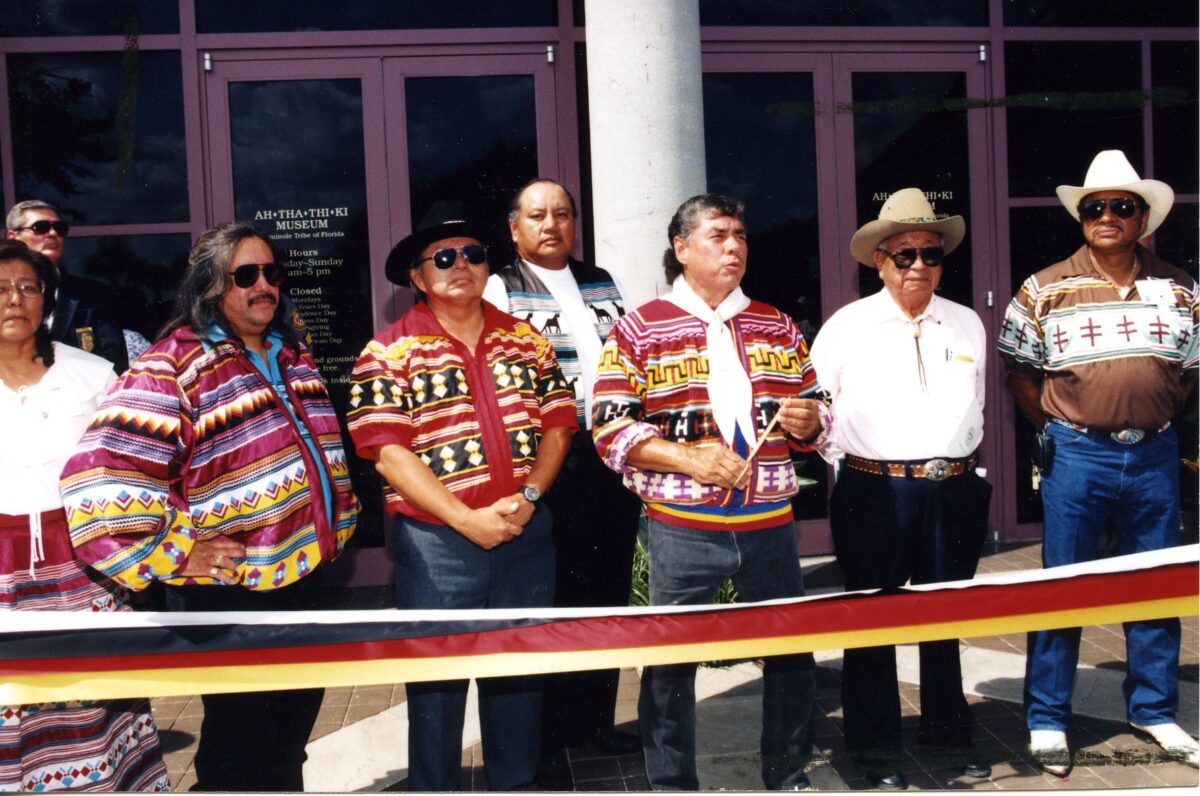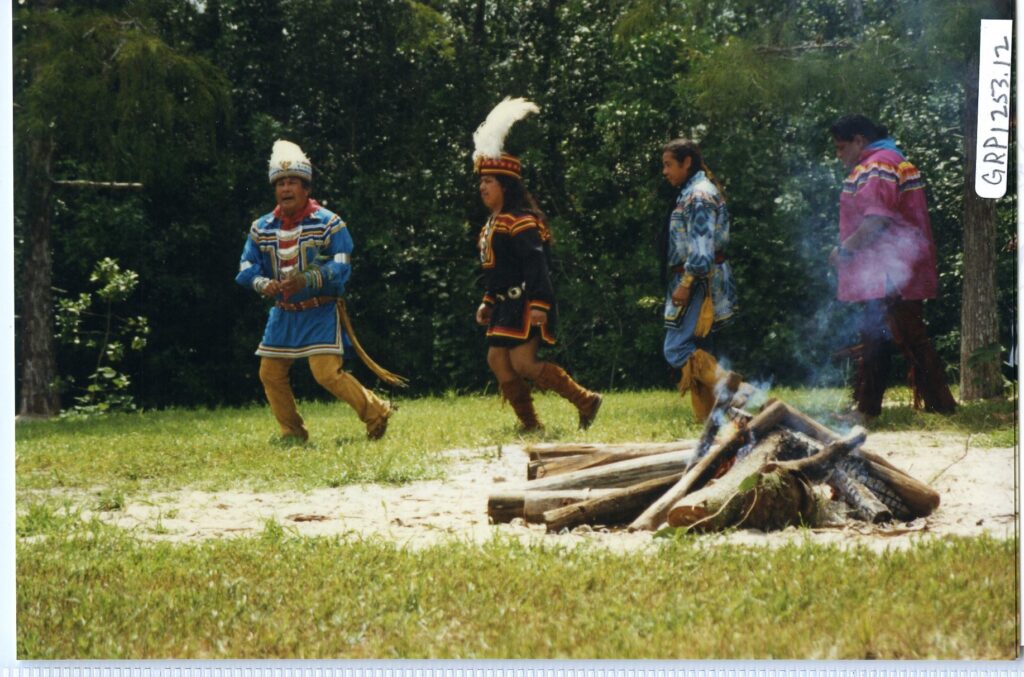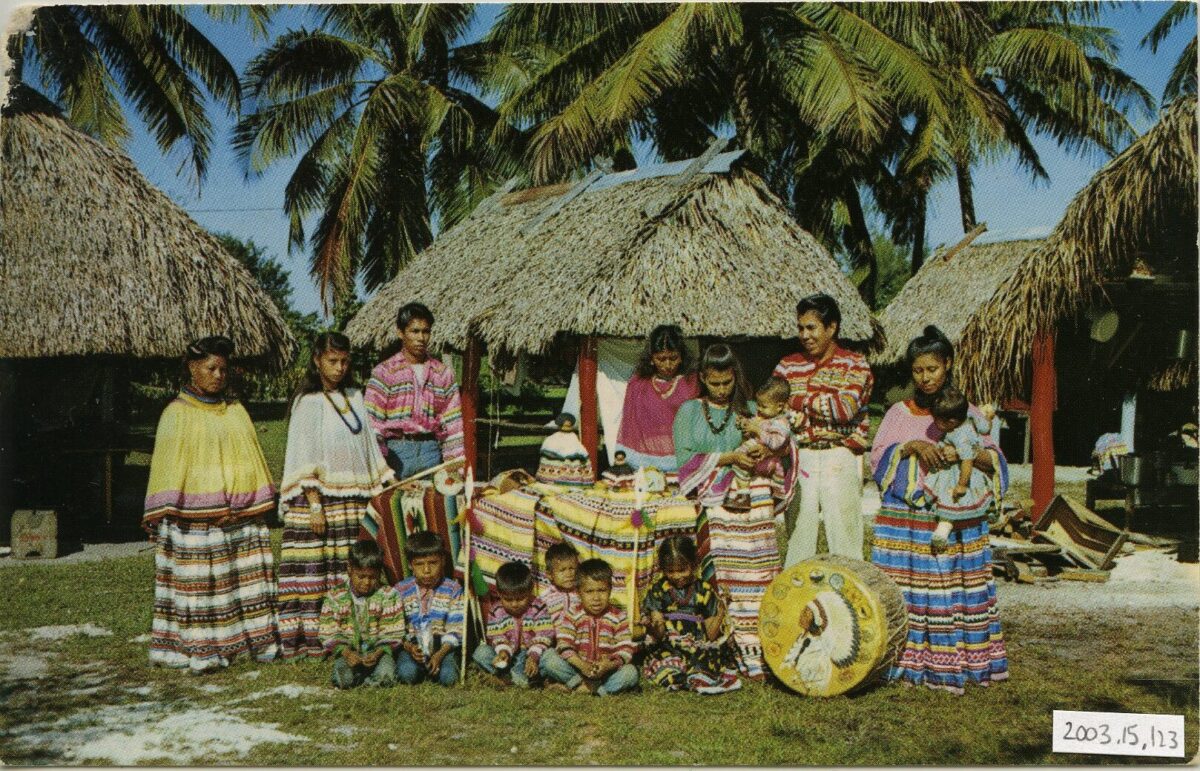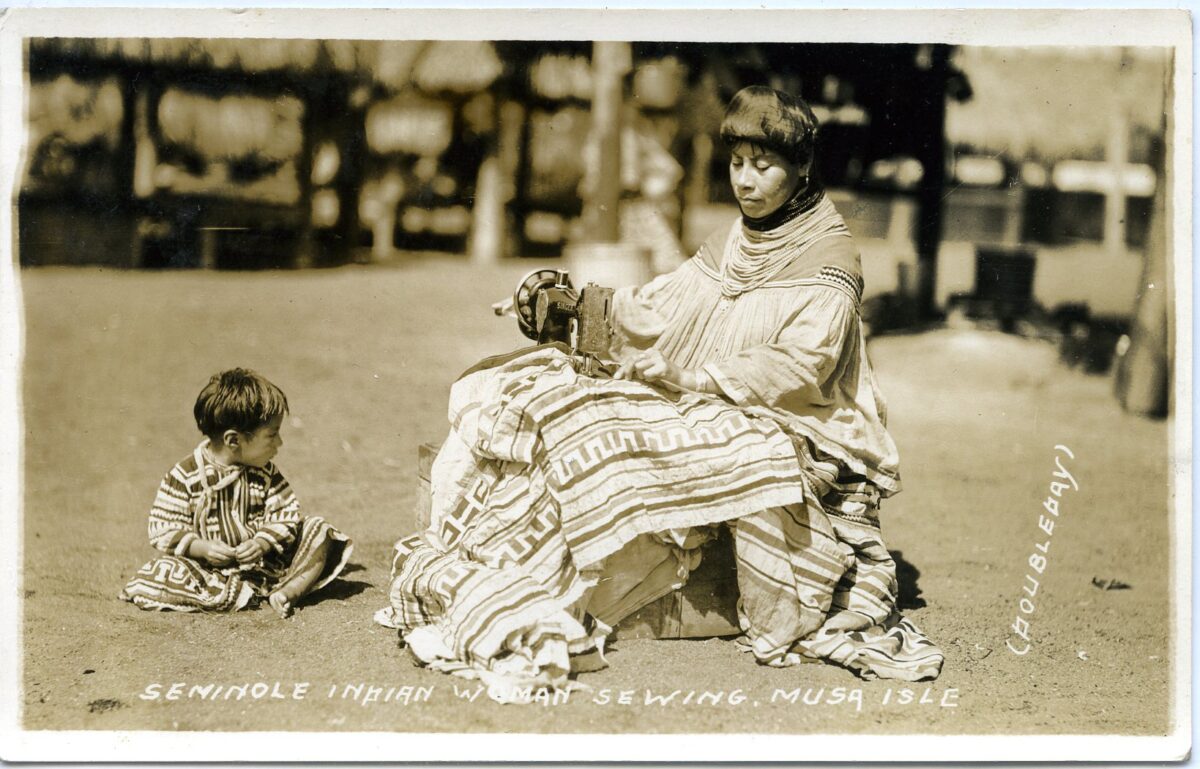
Ah-Tah-Thi-Ki Museum Turns 25
Do you know what August 21st is? It’s the 25th Anniversary of the Ah-Tah-Thi-Ki Museum (and the 65th Anniversary of Federal Recognition for the Seminole Tribe of Florida)! The grand opening of the Ah-Tah-Thi-Ki Museum was on August 21, 1997. This week, we will explore the mission, history, and triumphs of the Museum over the last 25 years. Read to the end for a quick peek at the current rotating offerings at the Museum! In addition, to honor of the anniversary, entrance to the Museum will be FREE on Sunday, August 21st. So, mark your calendars and come celebrate!
In our featured photo this week, you can see the ribbon cutting ceremony for the Grand Opening of the Ah-Tah-Thi-Ki Museum on August 21st, 1997. In the center, James Billie holds scissors in his hands, getting ready to cut. From left to right, you can also see Louise Gopher, David Cypress, Billy L. Cypress, Max Osceola, Frank Billie, and Mitchell Cypress.
The Mission
The Ah-Tah-Thi-Ki Museum is located on the Big Cypress Seminole Indian Reservation. In the Seminole language, Ah-Tah-Thi-Ki means “a place to learn, a place to remember.” The mission statement of the Museum is to “Celebrate, Preserve, and Interpret Seminole Culture and History.” Thus, the Museum strives to “promote a more holistic story that embodies the diversity of Seminole voices.” This is accomplished through many exhibits, programs, and management of the Museum Collections. The Collections contain items related to the Seminole Tribe of Florida, or the Native American tribes of the Southeastern United States. Presently, the Museum is home to almost 200,000 unique artifacts. As a result, the artifacts include recordings, newspapers, clothing, patchwork, dolls, baskets, photos, and more. Six core values drive the Museum; diversity, trust, service, inspiration, relevance, and passion.
The History
The dream of the Ah-Tah-Thi-Ki Museum took a lot of effort and passion to realize. In 1987, an internal study was conducted on the Tribe’s cultural programs under the direction of Chairman James Billie. The study revealed the need to “collect, preserve, and maintain the Seminole language and culture (ATTK Museum Grand Opening Booklet, 2006.71.102, ATTK Museum).” Consequently, the Tribal Council chartered the Ah-Tah-Thi-Ki Museum in January 1989. Soon, they adopted a Master Plan. At the beginning, the Museum’s objective stated it would “…serve as the central repository for artifacts and information of the Seminole culture, and further the study and documentation of the heritage, language, oral tradition, religion, music, song, dance, and material cultural items (ATTK Museum Grand Opening Booklet, 2006.71.102, ATTK Museum).”
The Museum started to take shape. Billy L. Cypress became the Executive Director of the Seminole Tribe Museum Authority in 1990. Soon, plans for Building One of the Museum were developed. Groundbreaking for the first building of the Ah-Tah-Thi-Ki Museum happened in January 1993. The Museum opened its doors on August 21st, 1997. The Grand Opening also helped commemorate the 40th anniversary of federal recognition of the Seminole Tribe of Florida. A large number of Tribal members, Tribal leaders, staff, volunteers, and more worked together to make the Museum what it is today. From the moment the doors opened, the Museum has continued to grow, expand, and work to fulfill its mission.
Expansion
The Ah-Tah-Thi-Ki Museum today has grown beyond the lofty dreams of 1997. Future plans were outlined in the Grand Opening Ceremony Program Booklet from 1997. They hoped the Museum would eventually “include classrooms, a conservation lab, an auditorium, and a dining area.” Part of this vision was realized in 2004. A second building was built for conservation purposes. It is dedicated to the curatorial and conservation needs, and contains a state-of-the-art collections vault and curatorial lab. Today, a glass wall allows visitors to watch the Conservator in the conservation lab. The American Alliance of Museums (AAM) awarded the Ah-Tah-Thi-Ki Museum full accreditation in April 2009. It is the first tribally-governed museum to have received accreditation. This speaks to the high professional and technical standards held at all levels of the Museum to this day.
The Museum Today
Even 25 years after its opening, the Museum continues to strive to achieve new goals, accomplishments, and areas of excellence. The Museum’s current Director is Gordon “Ollie” Wareham. He is the nephew of the late Billy L. Cypress. The Museum has big plans for the future, including a full-scale Museum Exhibit Redesign project. This redesign will help the Museum properly house their growing collection, and better share the Seminole story, culture, and history. The proposed redesign will “help tell a more complete story, one that showcases a longstanding history and a vibrant, living culture. It will reflect the voices, the stories, the history, and culture of the Seminoles.” Launched in FY18, this multi-year project is still in progress. But, the Museum has bold plans for the redesign, and the Museum’s future beyond it.
In October 2019, a third building on the Ah-Tah-Thi-Ki Museum campus was opened. The Major Billy L. Cypress Building is located between the Curatorial Building and the Museum. It has 10,000 square feet of interior space, and houses both Museum employees and Tribal Historic Preservation Office (THPO) employees. The THPO works to support the Tribe’s efforts to maintain their historic and cultural resources. The new building also houses a full Archaeological Collections lab, along with an Archaeological Collections vault. The Museum and the THPO work closely together, and the building represented another important accomplishment for the Tribe and the Museum. In a Seminole Tribune article about the building opening, past Big Cypress Board Rep. Joe Frank stated, “I think Billy would have been proud of his little project here. Now it’s a full-fledged museum and we are ready to move forward. There is still a lot of history out there.”

GRP1253.12, Bobby Henry Leads Stomp Dance, ATTK Grand Opening, 1997, ATTK Museum Collection
So…What can you see?
The Museum has a wide range of exhibits, programs, and activities for visitors to explore. With both outdoor and indoor offerings, there is something for any visitor! Below, we will explore the current rotating exhibits and outdoor offerings on the Museum’s campus. Some exhibits may only be available for 4-12 months, so check them out while you can! If you would like to learn more about the permanent exhibits at the Museum, check out this previous blog post on the Museum’s Virtual Tour. Also, make sure to read Essentials for a Big Cypress Reservation Visit for everything you need to know to be prepared!
Boardwalk, Village, and Hunting Camp
Although the boardwalk is always open (barring weather and nature events!) it is important to remember to take advantage of this important and exciting part of the Museum! The boardwalk is a mile-long raised loop within a 60-acre cypress dome. It passes by the Ceremonial Grounds, Clan Pavilion, Village, and Hunting Camp. Above, you can see a photo of Bobby Henry leading a Stomp Dance in the Ceremonial Grounds during the Ah-Tah-Thi-Ki Museum Grand Opening in 1997. During good weather, you may find village crafters in the Village, or demos in the Hunting Camp. The boardwalk is also part of the Great Florida Birding Trail. It is an ideal spot to find birds while on the Big Cypress Reservation. You can identify plants and animals with the help of signs posted along the boardwalk.
Alligator Wrestling: Danger, Entertainment, Tradition
In the West Gallery is a rotating exhibit titled Alligator Wrestling: Danger, Entertainment, and Tradition. It opened in December 16th, 2019. The exhibit explores the importance of alligator wrestling, the shared history wrestling has with the Seminole Tribe of Florida, and the danger that comes with it. Alligator wrestling is important to the Seminole people. From hunting alligators in the Everglades, to the strong relationships built between man and animal during wrestling shows, this exhibit explores Seminole alligator wrestling in a cultural context. The exhibit has both interactive displays, historic photographs, interviews, and more! To read more about the exhibit when it opened, read a previous blog post here. So, make sure to see it before it ends in October!
Home is Where the Heart Is
In the Mosaic Gallery, Home Is Where the Heart Is is a new exhibit from student artists at the Afachkee School (K-12) on the Big Cypress Reservation. It is a “colorful showcase capturing the excitement of being back in the art studio after emerging from the COVID lockdown.” It includes a number of independent pieces, as well as two large cooperative art works. Spanish Architect Antoni Gaudi inspires Stained Glass, a larger collaborative piece. It is composed of twenty tissue paper windows, each personalized by one of the student artists. Artist Jim Dine inspires the other collaborative display. A collection of oversized colored hearts share a message of unity, community, and love. In every piece in this collection, you can see a passion, excitement, and dedication to art and community.
Two Worlds: The Legacy of William Buffalo Tiger
In the Nook, Two Worlds: Heenechatche, The Legacy of Buffalo Tiger is available for only a short time longer! This exhibit if scheduled to be in the Nook until the end of August 2022. So, see it while you can! This exhibit explores the impact of William Buffalo Tiger. Tiger was vital to the independence of the Miccosukee Tribe. It “will focus on his contributions to the sovereignty and education of native people, and his lead in the fight to protect the Creator’s gifts.” Culturally similar to the Seminole Tribe of Florida, the Miccosukee Tribe gained state recognition separately from the Seminole Tribe of Florida in 1957. Federally, they gained recognition in 1962. Tiger was the first elected tribal Chairman of the Miccosukee Tribe. He worked to strike a delicate balance between adapting to the modern world and honoring traditional values.



